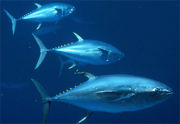Chordate
2008/9 Schools Wikipedia Selection. Related subjects: Insects, Reptiles and Fish
| Chordates Fossil range: Cambrian – Recent |
||||||||||||
|---|---|---|---|---|---|---|---|---|---|---|---|---|
 Yellowfin tuna, Thunnus albacares
|
||||||||||||
| Scientific classification | ||||||||||||
|
||||||||||||
| Classes | ||||||||||||
|
See below |
Chordates ( phylum Chordata) are a group of animals that includes the vertebrates, together with several closely related invertebrates. They are united by having, at some time in their life cycle, a notochord, a hollow dorsal nerve cord, pharyngeal slits, an endostyle, and a post-anal tail. Some scientists argue that the true qualifier should be pharyngeal pouches rather than slits.
The phylum Chordata is broken down into three subphyla: Urochordata, Cephalochordata, and Vertebrata. Some consider the Hemichordata a fourth chordate subphylum, but they are usually treated as a separate phylum. Urochordate larvae have a notochord and a nerve cord but these are lost in adulthood. Cephalochordates have a notochord and a nerve cord but no vertebrae. In all vertebrates except for Hagfish, the dorsal hollow nerve cord has been surrounded with cartilaginous or bony vertebrae and the notochord generally reduced.
The chordates and three sister phyla, the hemichordates, the echinoderms and the xenoturbellidae, make up the deuterostomes, a superphylum. The chordates are the largest phylum among the deuterostomes.
The extant groups of chordates are related as shown in the phylogenetic tree below. Many of the taxa listed do not match traditional classes because several of those classes are paraphyletic. Different attempts to organize the profusion of chordate clades into a small number of groups, some with and some without paraphyletic taxa, have thrown vertebrate classification into a state of flux. Also, the relationships of some chordate groups are not very well understood.
Classification
Taxonomy
The following schema is from the third edition of Vertebrate Palaeontology. While it is structured so as to reflect evolutionary relationships (similar to a cladogram), it also retains the traditional ranks used in Linnaean taxonomy.
- Phylum Chordata
- Subphylum Tunicata (Urochordata)— (tunicates, 3,000 species)
- Subphylum Cephalochordata (Acraniata)— (lancelets, 30 species)
- Subphylum Vertebrata ( Craniata) (vertebrates — animals with backbones; 57,674 species)
- Class ' Agnatha' * (jawless vertebrates; 100+ species)
- Subclass Myxinoidea (hagfish; 65 species)
- Subclass Petromyzontida (Lampreys)
- Subclass Conodonta
- Subclass Pteraspidomorphi (Paleozoic jawless fish)
- Order Anaspida
- Order Thelodonti (Paleozoic jawless fish)
- Infraphylum Gnathostomata ( jawed vertebrates)
- Class Placodermi (Paleozoic armoured forms)
- Class Chondrichthyes (cartilaginous fish; 900+ species)
- Class Acanthodii (Paleozoic "spiny sharks")
- Class Osteichthyes (bony fishes; 30,000+ species)
- Subclass Actinopterygii (ray-finned fish; about 30,000 species)
- Subclass Sarcopterygii (lobe-finned fish)
- Superclass Tetrapoda (four-legged vertebrates; 18,000+ species)
- Class Amphibia (amphibians; 6,000 species)
- Series Amniota (with amniotic egg)
- Class Sauropsida — (reptiles; 8,225+ species)
- Class Aves (birds; 8,800–10,000 species)
- Class Synapsida (mammal-like "reptiles"; 4,500+ species)
- Class Mammalia (mammals; 5,800 species)
- Class ' Agnatha' * (jawless vertebrates; 100+ species)
Phylogeny
| Chordata |
|
||||||||||||||||||||||||||||||||||||||||||||||||||||||||||||||||||||||||||||||||||||||||||||||||
|
|
Notes:
- Lines show probable evolutionary relationships, including extinct taxa, which are denoted with a dagger, †. Some are invertebrates. Chordata is a phylum.
- The positions (relationships) of the Lancelet, Tunicate, and Craniata clades are as reported in the scientific journal Nature.
Origins
The origin of chordates is currently unknown. The first clearly-identifiable chordates are reduced fish- or lancelet-like specimens from the Cambrian. Most speculations about their origin fit into one or more of these categories:
- A sediment-dwelling worm-like animal that evolved a flatter body and/or fins for swimming.
- A sessile tubular filter-feeder that evolved into a free-swimming animal via usage of fins. ( Tunicates, considered a chordate, are sessile filter feeders that have a tadpole-like larvae.)
- A drifting or swimming larva of some other kind of animal that eventually retained its swimming features into adulthood.
The notochord's stiffness in many chordates may have evolved to facilitate the effectiveness of alternating muscle contractions for swimming (in S-shaped movements). In other words, in order to bend the body, a muscle needs a rigid structure to pull against, and a notochord (at least before spines) is the main structure to provide this. Lack of a stiff body part would merely result in the shorting of the animal during muscle contractions instead of the bending motions needed for swimming.